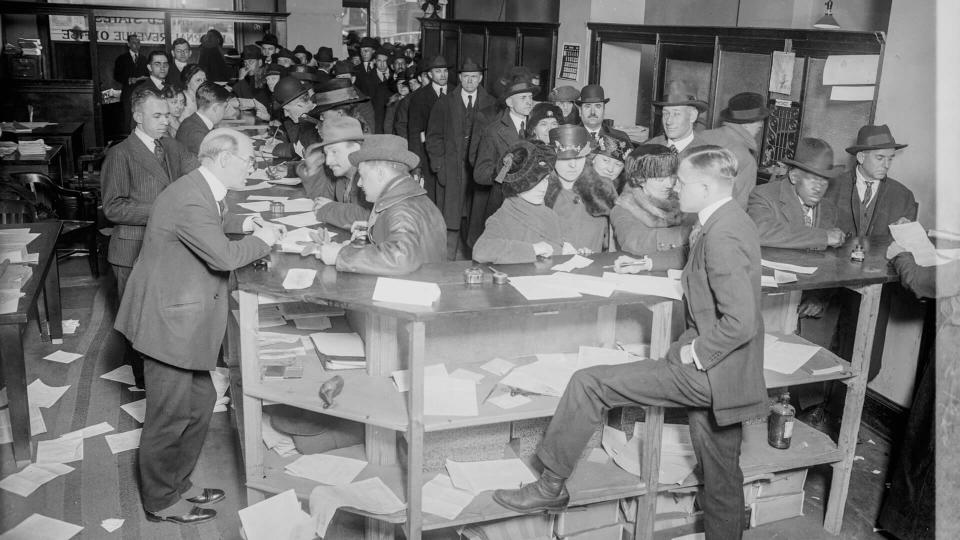How Much Household Income Was Considered Upper Middle Class in 1924?

Living in an ever-evolving economy, the only constant is change. From periods of depression to times of prosperity and recovery, the economic landscape of the nation is constantly growing and expanding, affecting how far a single American dollar goes in the process. Whether it’s covering household expenses, indulging in leisure activities or boosting savings, the financial status of the nation directly impacts every American’s wallet.
Learn More: Here’s How Much the Definition of Middle Class Has Changed in Every State
Find Out: 4 Genius Things All Wealthy People Do With Their Money
Given the impact of economic factors on individuals’ well-being, let’s take a closer look at what income was considered upper middle class in 1924 and how it compares to today’s economic standards.
The Economic Prosperity of 1924
Understanding the economic climate of 1924 requires a bit of context. Characterized by a recent World War, the nation was in recovery as it stepped into the Roaring ’20s.
This decade was a time of great transition due to major advancements in industrialization, technology and the stock market. This rapid economic evolution fostered the expansion of the middle class and opportunities for upward mobility, resulting in a trickle-down effect that impacted income distributions and class structures.
While the 1920s was categorized by great changes, it was a very prosperous time filled with social change and a splurge of interest in art. This decade saw a rise in flapper dresses, lively speakeasies and smooth jazz. Women gained the right to vote, cars became more accessible to buy, silent films transitioned to “talkies,” employment opportunities increased and the middle class enjoyed a higher standard of living.
Read Next: Here’s What the US Minimum Wage Was the Year You Were Born
How Much Household Income Was Considered Upper Middle Class in 1924?
During this economic boom, the average income of Americans was a seemingly meager $3,481, according to IRS tax documentation of the time. While “upper middle class” wasn’t officially classified on tax forms back then, a rough estimate of what would have constituted an upper-middle-class income would be approximately $3,481 to $6,962 (the average income to double the average income).
What This Number Looks Like in Today’s Dollar
Today, adjusting for inflation using the U.S. Bureau of Labor Statistics CPI inflation calculator, the income would be about $63,090 to $126,180.
In other words, an income ranging from $63,090 to $126,180 today would be necessary to maintain the needs of an upper-middle-class family in 1924.
What Did This Income Level Offer?
While an annual income of $3,481 to $6,961 might be incredibly modest by today’s standards, remember that the economic landscape was very different.
“This income level was essential for maintaining an upper-middle-class lifestyle at the time, which often included owning a car, investing in the stock market — which was particularly appealing and accessible during the Roaring ’20s — and participating in the burgeoning consumer culture,” said John F. Pace, CFA, tax partner at Pace & Associates. “These elements helped define the socio-economic status of the upper middle class during this period of technological and cultural shifts.”
For the time, this income was no meager feat. This income level afforded Americans a very comfortable lifestyle that went well beyond the bare minimum essentials.
“Imagine a spacious home with modern amenities (for the time) like electricity and indoor plumbing,” said Abid Salahi, co-founder of the personal finance and credit site FinlyWealth. “Groceries, clothing and entertainment were also all significantly cheaper compared to today.”
How Has the Economic Landscape Shifted Since?
With a century separating the 1920s from today, the nation’s financial landscape has naturally undergone great change and transformation since.
“While the basic structure of economic classes might still appear similar, factors like technological advancement, changes in global economic dynamics, inflation rates and shifts in job markets play a much more significant role today,” Pace said. “Moreover, today’s upper middle class deals with more complex financial products, a more extensive and integrated global economy, and different cultural values around money and spending.”
These changes reflect a nation with changing priorities. Over the past century, the economy shifted from having a focus on a manufacturing-driven economy to one centered around information and services, with this shift consequently shaping the concept of income.
Even With Higher Income, Today’s Economy Demands More
Despite witnessing a surge in income levels surpassing those of the 1920s, today’s economy features unequal income distribution and a widening gap between social classes. These changes have necessitated a higher standard of living and a consistently declining value of the dollar.
“While the headline number is higher, the modern upper-middle-class lifestyle demands far more,” Salahi said. “Housing costs, healthcare and education have all skyrocketed, squeezing household budgets. So, what’s changed? The social safety net of the 1920s was practically nonexistent. Today’s upper middle class might have a higher baseline income, but they also face more financial pressures due to increased costs of living and the need for things like health insurance.”
More From GOBankingRates
This article originally appeared on GOBankingRates.com: How Much Household Income Was Considered Upper Middle Class in 1924?

 Yahoo Finance
Yahoo Finance 